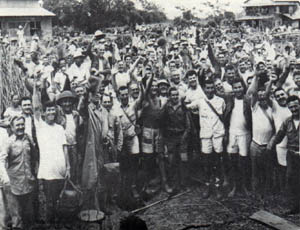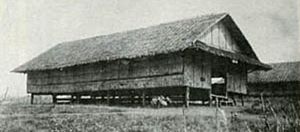Raid at Cabanatuan facts for kids
Quick facts for kids Raid at Cabanatuan |
|||||||
|---|---|---|---|---|---|---|---|
| Part of World War II, Pacific theater | |||||||
 Former Cabanatuan City POWs in celebration, January 30, 1945 |
|||||||
|
|||||||
| Belligerents | |||||||
| Commanders and leaders | |||||||
| Strength | |||||||
| 133 U.S. soldiers from the 6th Ranger Battalion and Alamo Scouts 250–280 Filipino guerrillas |
est. 220 Japanese guards and soldiers est. 1,000 Japanese near the camp est.5,000~8,000 Japanese at Cabanatuan City |
||||||
| Casualties and losses | |||||||
2 killed 4 wounded 2 prisoners died 9 wounded in action |
530–1,000+ killed 4 tanks out of action |
||||||
The Raid at Cabanatuan, also known as The Great Raid, was an amazing rescue mission during World War II. It happened on January 30, 1945, in the Philippines. American soldiers, called United States Army Rangers and Alamo Scouts, teamed up with brave Filipino guerrillas. Their goal was to free hundreds of prisoners of war (POWs) and civilians held by the Japanese army.
This daring rescue took place because General Douglas MacArthur and his American forces were returning to the Philippines in late 1944. There was a fear that the Japanese might harm the prisoners or move them to Japan. The raid successfully freed 511 prisoners from the camp. Even today, Army Rangers study this mission as a classic example of a successful and brave operation.
Contents
Why the Raid Happened
After the Empire of Japan attacked Pearl Harbor on December 7, 1941, the United States declared war. Japan also attacked American bases in the Philippines. Filipino and U.S. forces fought hard, but by May 1942, Japan controlled most of Southeast Asia.
The Bataan peninsula and the island of Corregidor were the last places the Allies held in the Philippines. On April 9, 1942, about 79,000 American and Filipino soldiers surrendered. They were starving and sick. They were forced to march 60 miles (97 km) in what became known as the Bataan Death March. Many died along the way. Some escaped and joined guerrilla groups in the mountains.
The soldiers captured on Corregidor on May 6, 1942, were not part of the Death March. They were taken to Manila and then sent to Cabanatuan camp number 1. Other American prisoners from Camp O'Donnell also joined them there.
Life at Cabanatuan Camp
By January 1945, after almost three years, nearly 3,000 prisoners had died at the camp. The camp was large, about 600 yards by 800 yards. It was surrounded by three barbed wire fences, each 8 feet high. There were also guard towers outside the fences.
The prisoners lived in 8 barracks. Each barracks was meant for 40 soldiers but held 120 prisoners. Conditions were terrible. Mosquitoes spread malaria, and flies spread diseases like dysentery. Many prisoners died because of the harsh conditions and mistreatment by guards. Local Filipinos tried to help by secretly bringing in food and money.
By 1944, things got even worse. The Japanese cut down on food and stopped the smuggling of supplies. They also started sending prisoners to other camps in Japan and Manchuria on dangerous "hellships." By early 1945, only a little over 500 prisoners were left at Cabanatuan camp.
American Forces Arrive in the Philippines
On January 9, 1945, American forces led by General Douglas MacArthur landed on Luzon, a main island in the Philippines. A few months earlier, Japan had given a terrible order: if a camp was in danger of being taken by American forces, all prisoners were to be killed.
The prisoners at Cabanatuan didn't know about this danger. But General MacArthur did. He had learned that the Japanese had killed almost all 150 prisoners at another camp on Palawan. MacArthur did not want this to happen at Cabanatuan. As the Americans got closer, about 30 miles (48 km) from the camp, the prisoners were in immediate danger. A rescue plan had to be made very quickly.
The 6th Ranger Battalion
General MacArthur had a special unit called the 6th Ranger Battalion. These soldiers were highly trained to work behind enemy lines. They were led by Lieutenant colonel Henry Mucci. In October 1944, they landed before the main American forces to destroy enemy positions. When the 6th Army landed on Luzon, the 6th Ranger Battalion was with them. General Walter Krueger, who commanded the 6th Army, learned about the Cabanatuan camp from American officers who had stayed with Filipino guerrillas.
Planning the Daring Rescue
The camp was 30 miles (48 km) behind enemy lines, and many Japanese troops were in the area. The POW camp itself also had Japanese soldiers staying there. Colonel Mucci put together a team of Rangers and two groups of Alamo Scouts. The total rescue force was 8 officers and 120 enlisted men.
The soldiers carefully studied aerial photographs, maps, and diagrams of the camp. The Alamo Scouts left on January 27 to meet with local Filipino guerrilla forces. They watched the camp closely. The Rangers would join them just before the attack.
On January 29, the Rangers met with Filipino guerrillas five miles north of the camp. Mucci learned that there were many Japanese troops moving in the area. He also found out that there were 90 guards in the camp, plus 150 soldiers staying there temporarily. Because of this, the raid was put on hold for 24 hours.
Colonel Mucci also arranged for 50 oxcarts to be ready near a river. These carts would carry prisoners who were too weak to walk. The raid was then planned for January 30, as night began to fall. A very important person for the raid was Filipino Captain Juan Pajota. He knew the area well and was the one who advised Mucci to wait 24 hours for some Japanese troops to move away.
The Great Raid
On the evening of the raid, Filipino guerrillas cut the Japanese phone lines to Manila. They then blocked the two roads near the camp. This was to stop other Japanese units from helping the camp guards.
The Rangers had to crawl about a mile through an open field. To keep the guards from seeing them, Colonel Mucci arranged for a P-61 night fighter plane to fly over the camp. The plane's noise would distract the guards. The Rangers split into two groups to attack the front and back gates of the camp.
They quickly broke into the camp and dealt with the guards. A surprising problem then happened: the prisoners hid from their rescuers! They didn't recognize the uniforms and thought the shooting meant they were all being killed. The Rangers had to convince the prisoners that they were there to rescue them. One British civilian prisoner hid and didn't leave with the others, but Filipino guerrillas found him later and took him to safety. Sadly, one prisoner died of a heart attack during the rescue.
The Filipinos and Alamo Scouts bravely fought off Japanese soldiers while the Rangers helped the prisoners get to the oxcarts. Six Rangers stayed behind as a rearguard, being the last to leave the camp. They came under fire from the Japanese, and one Ranger was killed.
At the river, a guerrilla doctor treated the wounded. Filipinos from nearby villages gave the prisoners food and water. The Rangers and prisoners traveled all night to reach the American lines. Only two Rangers, Corporal Roy Sweezy and Captain Fisher, were killed during the entire rescue.
The Raid at Cabanatuan was one of the most amazing and successful rescue missions in military history. The rescuers killed or wounded an estimated 523 Japanese soldiers while saving 511 prisoners.
Images for kids
-
Camp Pangatian Memorial Shrine (Raid at Cabanatuan City, maintained by the American Battle Monuments Commission)
See also
 In Spanish: El gran rescate para niños
In Spanish: El gran rescate para niños





















